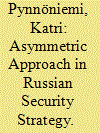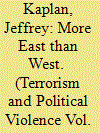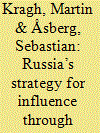|
|
|
Sort Order |
|
|
|
Items / Page
|
|
|
|
|
|
|
| Srl | Item |
| 1 |
ID:
166656


|
|
|
|
|
| Summary/Abstract |
Two observations stand out from the Russian strategic outlook. First, it corresponds with the real politik vision of world politics where the states engage in (zero-sum) competition for power and resources. Second, the new world order emerges because of a conflict between different models of development and value systems. These two observations highlight a certain “family resemblance” between the current Russian assessment of the current security environment and the situation during the Cold War. Furthermore, Russian national security strategy is oriented toward achieving strategic stability with the other great powers. The maintenance of strategic parity (nuclear and conventional deterrence) is a means to this end. However, given Russia’s relative weakness in comparison to its major geopolitical competitors, this has led to the renewal of the Cold War-era concept of asymmetric approach. Although this concept is most often used in the context of nuclear deterrence and the debate on “strategic stability,” it is not about military security only. The set of asymmetric measures from economic dependence or sanctions, to diplomatic, political, and informational measures are used to prevent an emergence of a conflict that would threaten Russia’s sovereignty and domestic stability. The purpose of this paper is to explore the Soviet roots of Active Measures and how the Soviet heritage is present at both the theoretical level and in concrete practices. Finally, insights from the conceptual analysis are applied in assessing the vulnerability of the Nordic countries, in particular Finland and Sweden, to Russian influence operations.
|
|
|
|
|
|
|
|
|
|
|
|
|
|
|
|
| 2 |
ID:
166650


|
|
|
|
|
| Summary/Abstract |
Before there was hybrid warfare or its more innocuously styled component information warfare, there were Soviet Active Measures (Aктивные мероприятия). Conceived in 1948 and fully implemented by the 1970s, Active Measures were a palate of techniques designed to both deceive the West and to turn Western public opinion toward whatever the Soviet policy of the moment might be. “More East than West” presents a brief introduction to the Active Measures program which is followed by a single case study, that of the World Council of Churches (WCC). The image of the World Council of Churches as a Cold War pawn of the Soviet Union has become set in the American popular consciousness. It was not always so. At its birth in 1948, the WCC was seen as a promising ecumenical experiment that might serve to better unite the Christian churches of the world. Its birth, however, coincided precisely with the emergence of the Cold War and the organization was soon dragged kicking and screaming into the conflict. The Americans in the era of President Harry S. Truman saw in the group a potential ally for the Roman Catholic Church in erecting a spiritual barricade against the encroachment of atheistic communism. After 1961, the Soviets saw the group as a useful conduit for propaganda messages as designed by the Active Measures program that designed and disseminated Soviet propaganda throughout the Cold War. In the end, Soviet influence came to dominate the group’s political positions, but it never became an actual front group and successive American Presidents carried on a range of relationships with the WCC. This article offers a history of the early years of the Cold War struggle over the soul of the WCC.
|
|
|
|
|
|
|
|
|
|
|
|
|
|
|
|
| 3 |
ID:
154814


|
|
|
|
|
| Summary/Abstract |
Russia, as many contemporary states, takes public diplomacy seriously. Since the inception of its English language TV network Russia Today in 2005 (now ‘RT’), the Russian government has broadened its operations to include Sputnik news websites in several languages and social media activities. Moscow, however, has also been accused of engaging in covert influence activities – behaviour historically referred to as ‘active measures’ in the Soviet KGB lexicon on political warfare. In this paper, we provide empirical evidence on how Russia since 2014 has moved towards a preference for active measures towards Sweden, a small country in a geopolitically important European region. We analyse the blurring of boundaries between public diplomacy and active measures; document phenomena such as forgeries, disinformation, military threats and agents of influence and define Russian foreign policy strategy. In summary, we conclude that the overarching goal of Russian policy towards Sweden and the wider Baltic Sea is to preserve the geostrategic status quo, which is identified with a security order minimising NATO presence in the region.
|
|
|
|
|
|
|
|
|
|
|
|
|
|
|
|
|
|
|
|
|